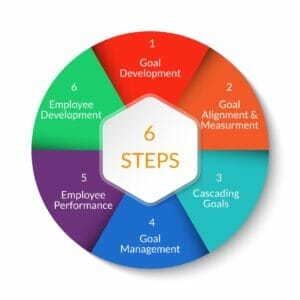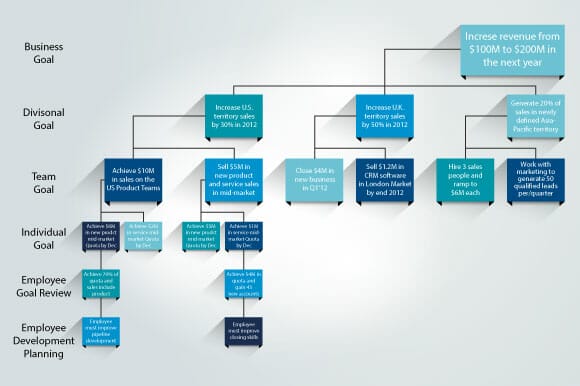Linking Cascading Goals to Employee Performance Management and Development Planning Improves Engagement

Linking Cascading Goals to Employee Performance Management and Development Planning Improves Engagement
An employees performance appraisal is often conducted without regard to corporate business needs and goals. Unclear goals and misalignment of enterprise efforts can limit both organizational and individual performance, resulting in reduced engagement levels.
Seldom do organizations cascade goals from the corporate office to departments to individual employees. Without this line of sight, companies struggle to manage overlapping accountabilities, workforce redundancies, and conflicting activities. It is not enough to simply conduct the annual strategic planning session and share these goals via corporate communications or team meetings. Organizations must align and cascade goals throughout the company to drive transparency, manage progress toward goals on a continuous basis, and evaluate overall strategy with individual performance. These six steps provide a guide on how to cascade organizational goals, align them with your performance management process, and create a relevant employee development plan that is connected to business strategy.

1. Goal Development
Success begins by developing three to five business goals that can be accomplished in a year. It is important not to focus on more than a few goals in a given year in order to maintain laser focus. It is also important to review previously set and new goals at the same time to ensure that they don’t conflict with each other. Goals should be based on your strategic plan and act as guideposts to help the company achieve its mission. For example, a company may have a goal to “Increase revenue from $100M to $200M in the next year.” This goal is specific and easy to understand, and can be adapted as needed based on changing business needs.
2. Goal Alignment and Measurement
Once an organization sets its top-level business goals, it can begin to align those goals to specific business units, divisions, or departments. Many departments can own the same goal, so it’s important to involve all senior leaders in the goal alignment process. Each senior leader should develop their three to five strategic imperatives and ensure they tie directly to the corporate goal. If we continue with the corporate revenue example above, this could break out into multiple imperatives. The outcome of this step is the definition of how and when each division will achieve the strategic imperatives within a designated timeframe.
Once all divisional goals are established or agreed upon, it is important to discuss them in an open forum to identify misalignment of goals across the company. The most common mistakes that occur during this phase include poorly defined goals, lack of metrics to measure success, lack of goal prioritization, and open-ended timeframes. By enabling the entire management team to collaborate, possible issues can be eliminated sooner rather than later, or possibly when it’s too late.
3. Linking Cascading Goals
After management has completed and agreed on the top-level goals, managers can then begin to cascade goals down to teams, individuals, or both. The cascading process positively impacts the performance of the company and increases value across the board. With cascading goals, employees understand:
- Exactly what the organization is focused on
- How their work contributes to the achievement of goals
- The overall team impact to the bottom line
Talent management programs should enable employees to view the connections between their goals, their manager’s goals, and the corporate strategies, driving company-wide transparency.
4. Goal Management
Goals identify what an employee needs to do to move toward the attainment of the corporate strategies. Setting goals involves a continuous process of decision making. Goal setting should be a joint process between the employee and manager. Managers must ensure that they are in a position to help employees develop and review their goals. Agreement on the goals will help ensure a mutual commitment to achieving them. The process of goal setting applies to everyone, whether a chief executive officer, nurse, or assistant.
Most career goals will include both short- and long-term activities. Also, when creating and linking cascading goals, people should allow for the fact that circumstances will often change. Goals must therefore be kept under review during each performance review cycle. Employees should track important tasks assigned to each goal and include start and stop dates, as well as metrics for success. By setting up this structure, employees are able to break down goals into a number of small tasks that they need to do each day in order to achieve a positive outcome. The following broad guidelines will help employees set achievable goals.
- State each goal as a positive statement. Employees’ career goals should be expressed positively using dates and times so that they can measure achievement. If employees do this, they will know exactly when they have achieved the goal, and can take complete satisfaction from having completed the task.
- Set priorities. When employees have several goals, managers should assign each one a weight and priority. This helps employees avoid feeling overwhelmed by too many goals, and directs their attention to the most important ones.
- Set realistic goals. It is important to set goals that can be achieved—they should be kept small and achievable. If a goal is too large, then it can seem that employees are not making progress toward it.
5. Employee Performance Management
Establishing, monitoring, and updating goals are an important talent management process, but tying employee performance to the achievement of goals is a crucial step in measuring accomplishments. The performance components that can be measured include both individual and team goals. Employees must evaluate each goal against specific performance measures. Measures are the yardsticks used to determine how successful the accomplishment was that the employee produced. Companies use lots of useful measures including quality, quantity, timeliness, productivity, financial, and cost effectiveness, to name a handful.
Once the employee has evaluated progress against the measure, they should solicit manager feedback as well as feedback from other constituents, such as peers and customers. Prompt feedback addressing employee performance is an essential component of a successful performance management program. Employees need immediate feedback on how they are doing if they are to stay motivated and engaged. Although feedback can come in many forms, written documentation on the actual performance plan is recommended, as well as a face-to-face to conversation to review the plan and brainstorm ways to improve next year.
6. Employee Development Planning
Performance reviews and input from managers and others sets the foundation for professional and personal development. Having a systematic process provides visibility into talent gaps and allows the linkage of learning plans to specific skill and performance gaps. Having a personalized employee development plan ensures that employees identify new knowledge, skills, and abilities to pursue and the learning resources needed to reach specific goals tied to organizational needs. Much like LinkedIn and Facebook, employees are regularly engaged in the performance development process because it is social and in real-time.
Employee engagement can be significantly improved given the right information and tools. Performance management programs that incorporate cascading goals aligned down to the individual level, and that enable continuous collaboration and monitoring of results with an extended community will result in engaged employees. Talent management technology has made all of this possible, and companies are reaping benefits in retention, financial rewards, and productivity. We encourage you to explore these options and put a process in place that makes talent management effective, enduring, and exciting for all involved.
Learn more about TalentGuard’s Talent Management Solutions and linking cascading goals:
- TalentGuard’s Performance Management software helps companies address their performance management challenges and keeps the appraisal process on track.
- Development Planning helps you create an employee development plan for your entire team, which accelerates the development of your people.

